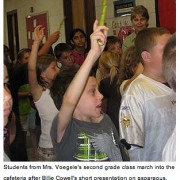Who knew eating asparagus could be so much fun?
The Triton School cafeteria took on a festive atmosphere May 28 as the lunch crew rolled out asparagus, steamed to perfection.
Sherry Sonnenberg, Dodge County Statewide Health Improvement Coordinator, and Kelley Marty, nutrition educator assistant with University of Minnesota Extension in Dodge County, walked between the cafeteria benches doling out stickers to the students who tried asparagus.
It’s OK if you don’t like it, Sonnenberg told the students, just try it.
Billie Cowell, food service director for Taher at Triton, greeted all 500 or so students in kindergarten through fifth grade with asparagus as they entered the cafeteria. She cut the asparagus from her home garden, she told them, encouraging the students to look at, touch or feel the asparagus.
Asparagus can grow an inch an hour and up to 12 inches a day, she said again and again as each class of students came for lunch. There are three colors of asparagus – white, green and purple.
She told some students the asparagus traveled from Lenora, Minn., only 72 miles from their school cafeteria. Their produce typically comes from California, about 1,900 miles away.
There were signs throughout the cafeteria and cameras too.
The asparagus celebration was part of a pilot Farm to School program of Taher, the company that provides food service to Triton and several other schools in the region, Cowell said. Taher is experimenting with locally grown food in lunches in an effort to increase the nutritional value of lunch.
Cowell said it’s also a way to support the agricultural community in Minnesota.
Sonnenberg said the purpose of the Statewide Health Improvement Program is to reduce obesity, increase activity and cease tobacco use. The Farm to School effort fits well as a way to improve nutrition in school lunches, she said.
Making the new food fun is a way to make an impression and encourage students to try it, Sonnenberg said. She was surprised by the overwhelming positive response from students. She went through 600 stickers over two days, giving them to students in grades kindergarten through 12.
“It was wild,” Cowell said. “It really took all of us to do it.”
Fourth grade students Brittany Beckett, Desirae Tangen and Amanda Berg all ate their asparagus. They said they’d talked about asparagus in the classroom, learning it’s good for them and that it grows 12 inches in a day. Berg and Tangen said they eat asparagus all the time, but it was Beckett’s second time to sample asparagus. They all gave it a thumbs up.
On Friday, the food service served spring greens, also from the Lenora farm. Stickers were given out and students who tried the greens were allowed to sign their name on a banner on the wall that read “Lettuce help you grow.”
Cowell said she had just enough asparagus for all the students who wanted to try asparagus to try it. She ordered two 15-pound cases. She had plenty of spring greens, she ordered 45 pounds.
“It’s hard to judge what kids are going to do,” Tiffaney Lamoree, food service clerk said.
The effort is focused on the elementary children, because it’s easier to get them to change their eating habits and try new things, Cowell said.
Also that week, students in first grade planted a garden in a glove under Marty’s guidance and sampled a cucumber and radish. Their glove gardens had broccoli, cumcumber, radish, carrots, lettuce seeds wrapped in a wet cottonball.
As they left the cafeteria, Cowell asked a couple students if they liked the asparagus. There was a nod no, but Cowell was undeterred, telling the student that’s OK.
“Good job,” she said. “I’m proud of you for trying it.”
By Janet Kubat Willette
jkubat@agrinews.com
http://www.agrinews.com/asparagus/is/home/run/in/triton/farmtoschool/project/story-2617.html



